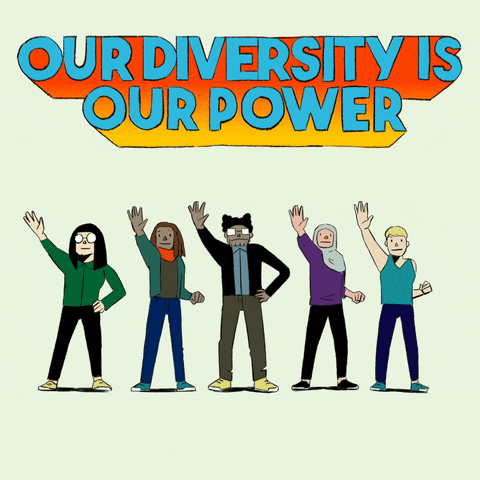Languages are not only the representatives of the spirit of a society: their grammars are also the unarmed army which enforces the guidelines each society creates for itself, the norm, making sure that every speaker is conforming to those rules. This may not be easy to acknowledge if you belong to the same group of those who invented the rules, but if you are part of a minority (and even when you’re part of a majority, as is the case with women, who are actually more than the men on this planet) you may feel excluded and not respected. In the last decades much has been done to right this wrong, and debates are still very heated in many linguistic communities. Feminist, LGBTQ+ and antiracist movements are still doing a great job trying to get rid of gendered and race-biased language, and nowadays companies, universities and institutions like NATO have their own policies about inclusive language in order to make their workers feel more respected.
So, what exactly is inclusive language? It’s the best remedy against centuries of political and linguistic discrimination. Inclusive language avoids using words that may be considered to exclude underprivileged and underrepresented groups such as racial and ethnic minorities and LGBTQ+ people, and it is used to keep away from offensive stereotypes. Need an example of linguistic discrimination? Dr. Rachele Levine, who's recently been nominated assistant secretary for Health and Human Services by Joe Biden, is the first openly transgender federal official in a Senate-confirmed role. Months ago, during a radio interview, she had to ask the reporter not to misgender her, because the presenter kept calling her 'Sir'. How would you feel if someone addressed you using the wrong pronoun? Exactly, now you get it.

Gender neutral language is used to make sure that everyone feels accepted and respected, and gender-neutral pronouns are one of the resources languages can deploy. A gender neutral or gender inclusive pronoun is a pronoun which doesn’t link the person who’s being discussed with a gender. Languages such as English lack a gender neutral pronoun, so it’s common to use ‘he’ when talking about a generic third person individual, or something like ‘he/she’. However, gender neutral pronouns have been created and used in order to obtain a greater equality. The most used is ‘they’, but pronouns such as ‘sie’ and ‘zie’ are now used by many members of the LGBTQ+ community. Singular ‘they’, controversial as it is, is old — Emily Dickinson used it in a letter in 1881, for instance — though its use as a non-binary pronoun is new.
Meaning
Singular they is the use of they to agree to with a singular antecedent as in the sentence "Everyone said they knew what they were doing." As you get from this example, it's mostly used with an unspecified antecedent ('somebody', 'nobody' or nouns which do not refer to one person but rather to a category such as 'the patient', 'the student', 'a judge', 'a mother ', etc.). Its use has been criticised by many commentators since the 18th century, but nowadays it is formally accepted as a gender-neutral, more inclusive pronoun. What’s new is that the singular ‘they/them/their’ is now used as a pronoun of choice for non-binary people, that is for people who do not identify themselves as males or females.
Example #1
Anne ate their lunch early because they were hungry.
Example #2
They are TJ, my best friend.
Example #3
I called Lou, but I couldn't speak to them because they didn't hear the phone ringing.
Origin and etymology
Where does the pronoun they come from? Old English used the third-person pronoun hīe, which was gradually replaced by an Old Norse borrowing, the demonstrative þeir, and then disappeared around the 15th century. Þeir, in turn, became they as it is known in Modern English today. Þeir originates from Proto-Germanic *þai-z ("those"), from Proto-Indo-European *toi ("those").
The pronoun ‘they’ can actually be used as a singular, and this practice has been documented since the 14th century. It developed as a singular following the use of the singular ‘you’, which was originally just a plural form. Examples of the usage of singular 'they' date back to Chaucer and Shakespeare, and were used throughout the centuries. Writers such as Jane Austen, Emily Dickinson and W. H. Auden used it in their works.
Since 2019, this new usage of the singular ‘they’ as a neutral personal pronoun referring to non-binary people has been accepted and included by some of the most well known style guides, including the Associated Press, the American Psychological Association and the Modern Language Association of America, and it was even celebrated as 2019 Word of the Year by Merriam-Webster dictionary.
Ludwig’s wrap up
Inclusive language aims at avoiding discrimination based on gender, race or socioeconomic status. Language reflects and influences attitudes, behaviour and perceptions, so as the world changes and moves toward a more gender-inclusive attitude, language is adapting to those needs. Gender neutral pronouns such as ‘they’ are used to refer to individuals whose gender is neither male nor female (nonbinary, genderfluid, agender, etc.), to express their identities. Language matters, so don’t forget to show you care about others: sometimes it only takes a pronoun!








